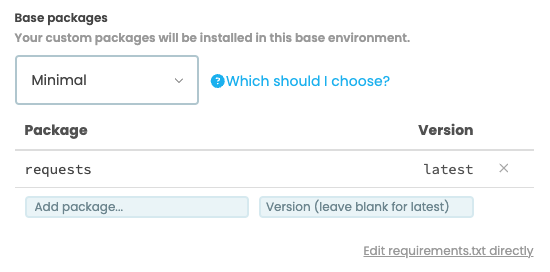Making HTTP requests
From client code
Anvil’s HTTP module allows you to make any HTTP requests that will run from client code.
Calling anvil.http.request
Begin by importing the anvil.http module.
import anvil.httpOnce you have imported the anvil.http module, you make web requests using the anvil.http.request function.
resp = anvil.http.request("https://api.mysite.com/foo")
print(f"Response MIME type: {resp.content_type}")There are a range of arguments to allow you to specify the HTTP method, custom headers, data to send in the request body, and other things you need to include. See this section of API docs for a full list of parameters.
resp = anvil.http.request(url="https://api.mysite.com/foo",
method="POST",
data="Data to post",
headers= {
"Authentication": "my-access-key",
})
print(f"Response MIME type: {resp.content_type}")When making requests from client code, you should be aware of Browser Restrictions.
Using the response
If the HTTP status code is successful (200-299), the anvil.http.request function returns the response body of the request.
By default, this will be a Media object.
response = anvil.http.request("http://ip.jsontest.com")
print(f"The response body was {response.get_bytes()}")If the json parameter is set to True, a JSON-decoded object will be returned.
response = anvil.http.request("http://ip.jsontest.com", json=True)
print(f"My IP address is {response['ip']}")HTTP error codes
If the HTTP status code is an error code, an anvil.http.HttpError will be raised. HttpError has two attributes:
status- The HTTP status code (a number)content- The response body (JSON-decoded as above if possible, or aMediaobject if JSON decoding has failed)
# This code will print "Error 404":
try:
anvil.http.request("https://anvil.works/404")
except anvil.http.HttpError as e:
print(f"Error {e.status}")URL-encoding strings
The HTTP module also contains functions for URL-encoding and URL-decoding strings. This is useful when constructing links to other sites, or URL-encoding URL hash parameters in an Anvil app.
# Prints "Hello%20there"
print(anvil.http.url_encode("Hello there"))
# Prints "Hello there"
print(anvil.http.url_decode("Hello%20there"))Browser Restrictions
Web browsers restrict the HTTP requests you can make from form code. When the web browser disallows a request, an HttpError is raised with a status of 0. The easiest solution is to make your request from a Server Module instead.
A client-side HttpError with status 0 is usually for one of three reasons:
-
The URL is inaccessible (cannot connect to host).
-
You’re requesting an unencrypted (
http://) URL. All Anvil apps are served over encrypted links (HTTPS), so the browser does not allow unencrypted requests from client-side code. -
The URL doesn’t obey the cross-origin rules. (It needs to respond to an OPTIONS request, have the right CORS headers, etc.)
There are two possible ways to remedy this error:
-
Make the URL behave correctly. (Make sure it’s accessible, serve it over HTTPS, give it the right CORS headers, and so on. This will require some expertise with web serving, and requires you to control the URL you are requesting. You may need to open up your browser’s developer tools to work out precisely what the problem is.)
-
Make the request from a server module instead. Server modules don’t run in the web browser, so they don’t have any of the browser’s limitations.
From server code
You can make requests from server code by using Python’s requests library.
Install the library from the Python version section of your App Settings, or select one of the base environments in which it’s already included.

Import the library and make a request using the requests.get function. This will return a Response object.
import requests
resp = requests.get("https://api.mysite.com/foo")To get a JSON object, use the built-in JSON decoder on the response:
resp = requests.get("https://api.mysite.com/foo")
print(resp.json())For more details on how to use the requests library, take a look at their documentation.
Do you still have questions?
Our Community Forum is full of helpful information and Anvil experts.

